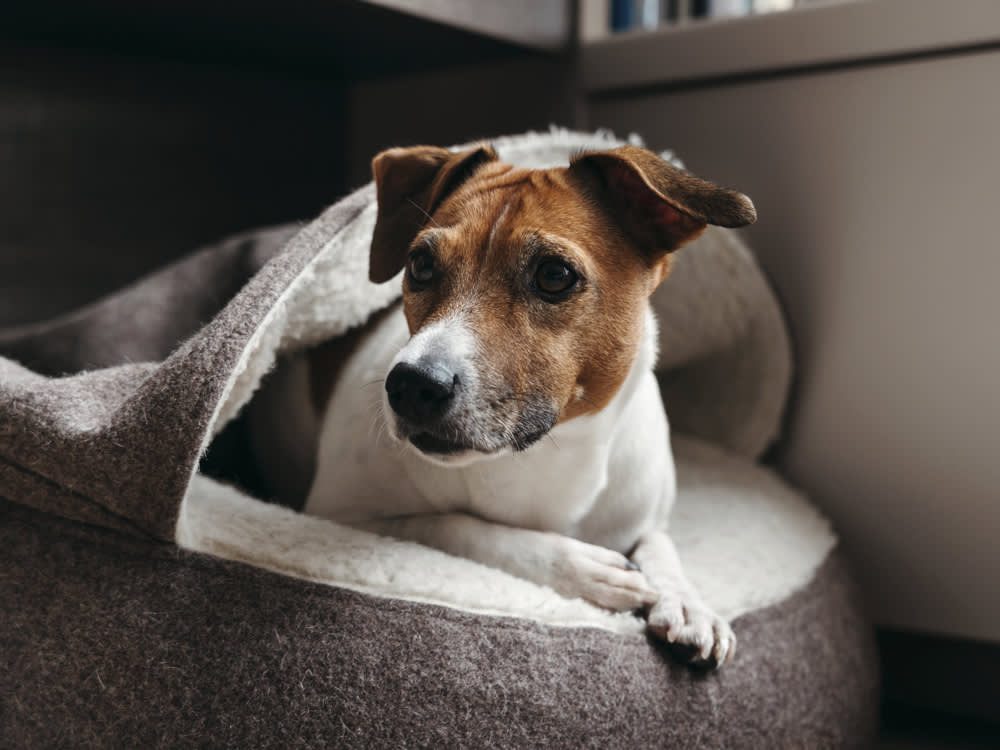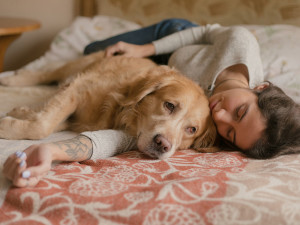How to Help Thunder Phobic Dogs
Tips for comforting your pup during a storm.

share article

Your pet wants you to read our newsletter. (Then give them a treat.)
As pet parents, many of us know what comes after the lightning during a storm: absolute terror in our dogs as they anticipate the thunder. That terror can take the shape of trembling, hiding under the coffee table, howling, and other expressions of doggy dread. And who knows what happens when we’re not home and a sudden thunderstorm descends (the horror!)
But for many dogs, storms bring panic and fear. Sometimes this fear even extends to the precursors to thunder, like dark skies, lightning, or changes in barometric pressure. We totally understand the loud BOOMs can be scary, but is there something else that our canines are reacting to? Experts hypothesize that some dogs are particularly sensitive to noise; another explanation is that the storms can cause static buildup in their fur that causes a shock sensation.
Understanding the Fear
Nancy Dreschel, DVM, an Associate Teaching Professor at PennState, published a studyopens in a new tab on the reactions of thunderstorm phobic dogs. She investigated the common stress signs of dogs during thunderstorms, including pacing, salivating, panting, trembling, whining, hiding, and increased salivary cortisol levels.
The small study found having a sympathetic owner does not lower the stress reaction of dogs that become anxious or fearful during noisy thunderstorms. But dogs who live with other dogs were more likely to have less pronounced stress reactions and more rapid recovery than dogs in single-dog households. That’s good news for dogs living in multi-dog homes. But Dr. Dreschel cautions pet parents of dogs with thunderstorm anxiety against getting additional dogs.
Even though it seems that comfort from humans (like petting and speaking calmly) didn’t lower stress levels, Dr. Dreschel found that dogs would still seek this comfort. “Many of the dogs in our study (both those who lived with other dogs and those who were the only dog) sought out this type of comforting from their human companions.”
Tips for Soothing Your Dog During a Storm
So what can you do to help comfort your fearful pup before and during a thunderstorm? “For dogs with thunderstorm phobia… offering a safe place to go (covered crate, basement, etc.), behavior modification (counter-conditioning and desensitization), pheromone therapy and anti-anxiety medication,” Dr. Dreschel suggests.
Comfort your pup
You know best what helps your pup calm down: petting them, praising them, scratching their favorite spot under their chin. Some pups respond positively when you play soothing music.
Cancel the noise out
You can try drowning out the sound with the TV (DogTVopens in a new tab has special programming for pups) or a fan — there are even canine noise-reducing headphones, such as Mutt Muffsopens in a new tab, to muffle storm noises.
Distract them
Plan to be home if you know a storm is coming so you can keep your pup occupied with their favorite tug toy or by filling a Kongopens in a new tab with their favorite treats. Make sure your pup gets some exercise, too, to get rid of that anxious energy.
Consider a thundershirt
Humans joke about these things, but they really can help: the Thundershirtopens in a new tab or Anxiety Wrap opens in a new tabare the equivalent of swaddling your pup like a baby, applying gentle pressure to calm their nerves.
As a long-term solution, the American Humane recommends counter-conditioningopens in a new tab your dog to thunderstorms as a preventative measure. It’s essentially training your pup to display a different behavior than their current reaction to a stimulus (aka the thunder.) You probably want to consult a trainer for this, as it involves exposing your dog to the scary sound at a low volume, gradually increasing it as you reward them with a toy or treats.
If your dog has a serious fear, you should always speak to your veterinarian, who can potentially recommend anti-anxiety medicine or herbal remedies.

JoAnna Lou
JoAnna Lou is a New York City-based researcher, writer and agility enthusiast.

